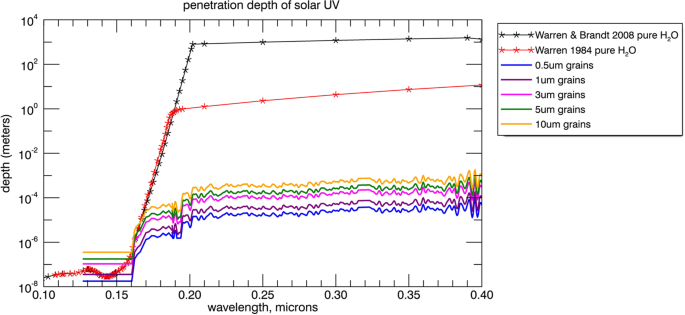
Low effective ultraviolet exposure ages for organics at the surface of Enceladus
- Select a language for the TTS:
- UK English Female
- UK English Male
- US English Female
- US English Male
- Australian Female
- Australian Male
- Language selected: (auto detect) - EN
Play all audios:

The saturnian moon Enceladus presents a remarkable opportunity in our solar system for searching for evidence of life, given its habitable ocean and plume that deposits organic-bearing ocean
material onto the surface. Organic ocean material could be sampled by a lander mission at Enceladus. It is of interest to understand the amount of relatively pristine, unaltered organics
present on the surface, given the ultraviolet (UV) and plasma environment. Here, we investigate UV penetration into Enceladus’s surface and the resultant effective exposure ages for various
regions, using the UV reflectance spectrum of Enceladus as measured by the Hubble Space Telescope and considering the rate of resurfacing by plume fallout. In high plume fallout regions near
the south pole, plume grains are buried by fresher grains within years, resulting in low levels of exposure to solar UV, which penetrates only ~100 micrometers. Regions at latitudes south
of ~40°S can have exposure ages 7 MeV) can access within 50° of equator, with higher latitudes bombarded only by >10 MeV electrons with very low fluxes.
Nordheim et al. (2017)46 also studied depth-dose rates for particles of different energy ranges at Mimas. On the trailing hemisphere, the uppermost 10 micrometers within the lens (with a
maximum latitude of ~35°) reaches a significant dose on timescales of 103-104 years. At deeper depths, the lens-like region shrinks as only the most energetic electrons with the greatest
penetration range into the ice are capable of reaching those depths. At 10 mm depths the dose is negligible. On the trailing hemisphere, at latitudes beyond ±20°, the surface receives a
negligible energetic electron dose and is therefore not likely to be heavily processed; the trailing hemisphere does not receive any significant energetic electron dose at cm depths.
On the leading hemisphere of Mimas, within ±15° of equator, a significant dose is reached on timescales of 105.5-106 years, while the timescale for surrounding regions is 106-108 years. At
>40 mm depth, the electron dose within the lens is negligible, with modification timescales of ~109 years – consistent with the idea that the electron flux spectrum drops off rapidly with
increasing energy.
Because Mimas is a worst-case scenario estimate for electron fluxes and bombardment patterns at Enceladus, we can conclude that at the equatorial regions of Enceladus, electron bombardment
is likely to be the most important, though still at relatively low fluxes (especially compared to Europa or even Mimas). At higher latitudes, and importantly for the high southern latitudes
where plume fallout is greater, the plume fallout dominates over electron effects.
An effective surface age can be defined for any region on the Enceladus surface, given the solar UV penetration depths estimated above and considering plume material fallout/deposition rates
across the Enceladus surface.
The estimated depth of the wavelengths able to break C-C bonds in glycine (
